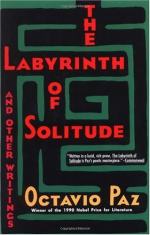
|
| Name: _________________________ | Period: ___________________ |
This test consists of 15 multiple choice questions and 5 short answer questions.
Multiple Choice Questions
1. What happens when the Mexican dissimulates?
(a) He merges with the common people.
(b) He nearly ceases to exist.
(c) He becomes estranged from society.
(d) He preserves his individuality intact.
2. In the book's argument, what happens when a Mexican woman is passive?
(a) She can no longer relate to the man.
(b) She embodies the ancient elements of earth, motherhood, and virginity.
(c) She comes to believe in the societal values given her.
(d) She functions as a channel of the ancient elements: Earth, motherhood, and virginity.
3. In Paz's estimation, what vital word has the Mexican forgotten?
(a) The word of love given to him by his mother.
(b) The word tying him to life forces of creativity and destruction.
(c) The word that allows him to reach out to others.
(d) The word that gives him peace with all others.
4. Why is the fiesta, at its core, a revolution?
(a) It dissolves society.
(b) It allows man to be something different.
(c) Man is finally free.
(d) It has no regard for religious mores.
5. Where does Paz state that the Mexican's indifference hides his life force?
(a) Within a jumble of emotions.
(b) Behind a veil of rationalism.
(c) In silence.
(d) Behind a death mask.
6. How do Mexicans perceive an opening-up of one's self?
(a) As a moment of truth.
(b) As infidelity to the human spirit.
(c) As a sign of strength.
(d) As a betrayal or weakness.
7. According to Paz, what does it mean when a person is alone?
(a) He is inferior.
(b) He can never relate to other people.
(c) He is superior.
(d) He is different.
8. What connotation does the verb, chingar, carry?
(a) Disaster.
(b) Failure.
(c) Mythical power.
(d) Violation.
9. To which of the following does Paz reduce the Mexican character? (Chapter Four, page 73).
(a) The Mexican is himself only in the crowd of a fiesta or ceremony.
(b) The Mexican only lives when he faces death.
(c) The Mexican does not dare or want to be himself.
(d) The Mexican is stronger when he is alone.
10. What masculine trait enters into the idea of feminine modesty?
(a) Vanity.
(b) Strength.
(c) Love.
(d) Protection.
11. When Paz first arrived in the United States, what surprised him most about the people?
(a) Their honesty and sense of community.
(b) Their confidence in the future of the nation.
(c) Their confidence and self-assurance.
(d) Their lack of openness.
12. During the fiesta of Grito, why do the people shout for one hour, in Paz's interpretation?
(a) To express their rage.
(b) So they can be silent the rest of the year.
(c) So the name of Grito cannot be heard.
(d) To express great joy.
13. What does the Mexican value in art, religion, and politics?
(a) Originality.
(b) Form.
(c) Purity.
(d) Equality.
14. To follow Paz's previous argument, what is the result when one Mexican confides in another?
(a) Affection.
(b) Sadness.
(c) Dishonor.
(d) Alienation.
15. How did Paz consider his philosophical questions?
(a) As meaningful only if they addressed the question of Mexican identity.
(b) As a waste of time.
(c) As the only means to find answers.
(d) As an excuse for not facing reality.
Short Answer Questions
1. Why does a Mexican blend into his surroundings and become solely Appearance?
2. Why does the worker lack mystery?
3. According to Paz, what is the Mexican's relationship with his fellow man?
4. Aside from being an excess, what does the fiesta revolt against?
5. Why does the modern novelist rarely choose the worker as his protagonist?
|
This section contains 639 words (approx. 3 pages at 300 words per page) |

|




